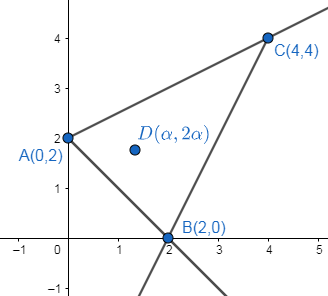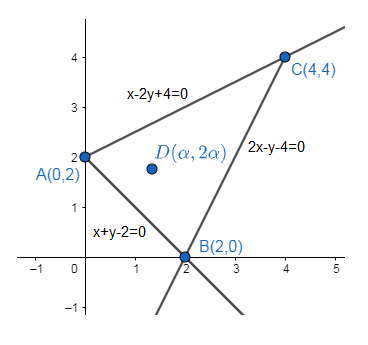
The values of \[\alpha \] if \[(\alpha ,2\alpha )\]lies inside the \[\Delta ABC\] if
\[A(0,2),B(2,0)\]and \[C(4,4)\]
(a) \[\alpha \in \left( \dfrac{1}{3},\dfrac{2}{3} \right)\]
(b) \[\alpha \in \left( \dfrac{2}{3},1 \right)\]
(c) \[\alpha \in \left( \dfrac{2}{3},\dfrac{4}{3} \right)\]
(d) \[\alpha \in \left( \dfrac{1}{3},1 \right)\]
Answer
609k+ views
Hint: Find the equation of the lines which are forming the triangle.
The figure for the given problem is as follows:

Now we will find the equations of all the three sides of the triangle.
We know equation of line between the two points \[({{x}_{1}},{{y}_{1}})\] and \[({{x}_{2}},{{y}_{2}})\]can be written as,
\[\dfrac{y-{{y}_{1}}}{{{y}_{2}}-{{y}_{1}}}=\dfrac{x-{{x}_{1}}}{{{x}_{2}}-{{x}_{1}}}\]
Applying the above formula, the equation of side AB is,
\[\dfrac{y-2}{0-2}=\dfrac{x-0}{2-0}\]
\[\dfrac{y-2}{-2}=\dfrac{x}{2}\]
\[\dfrac{y-2}{-1}=\dfrac{x}{1}\]
On cross multiplication, we get
\[y-2=-x\]
\[x+y-2=0........(i)\]
Similarly, the equation of side BC is,
\[\dfrac{y-0}{4-0}=\dfrac{x-2}{4-2}\]
\[\dfrac{y}{4}=\dfrac{x-2}{2}\]
\[\dfrac{y}{2}=\dfrac{x-2}{1}\]
On cross multiplication, we get
\[y=2x-4\]
\[2x-y-4=0........(ii)\]
And, the equation of side AC is,
\[\dfrac{y-2}{4-2}=\dfrac{x-0}{4-0}\]
\[\dfrac{y-2}{2}=\dfrac{x}{4}\]
\[\dfrac{y-2}{1}=\dfrac{x}{2}\]
On cross multiplication, we get
\[2y-4=x\]
\[x-2y+4=0........(iii)\]
Therefore the figure with equations is,

Two given points \[\left( {{x}_{1}},\text{ }{{y}_{1}} \right)\]and \[\left( {{x}_{2}},\text{ }{{y}_{2}} \right)\]will lie on the same side of the line \[ax+by+c=0\] if \[a{{x}_{1}}+b{{y}_{1}}+c\] and \[a{{x}_{2}}+b{{y}_{2}}+c\] will have same signs.
From the above figure it is clear that the points B and D lie on the same side of the line AC. So, it should satisfy the above condition, i.e.,
\[2-2(0)+4=6>0\]
So, when we substitute the value of point D in line AC, it should be greater than zero, i.e.,
\[\alpha -2(2\alpha )+4>0\]
\[\alpha -4\alpha +4>0\]
\[-3\alpha +4>0\]
\[4>3\alpha \]
\[\Rightarrow \alpha <\dfrac{4}{3}.........(iv)\]
Now from the above figure it is clear that the points C and D lie on the same side of the line AB. Substitute value of point C in equation of line AB, we get
\[4+4-2=6>0\]
So, when we substitute the value of point D in line AB, it should be greater than zero, i.e.,
\[\alpha +2\alpha -2>0\]
\[3\alpha -2>0\]
\[3\alpha >2\]
\[\Rightarrow \alpha >\dfrac{2}{3}.........(v)\]
So, from equation (iv) and (v), we get
\[\alpha \in \left( \dfrac{2}{3},\dfrac{4}{3} \right)\]
Hence the correct answer is option (c).
Note: We can solve this by finding boundaries of x and y. But the options are given in fraction form, using this method it gives the exact answer.
The figure for the given problem is as follows:

Now we will find the equations of all the three sides of the triangle.
We know equation of line between the two points \[({{x}_{1}},{{y}_{1}})\] and \[({{x}_{2}},{{y}_{2}})\]can be written as,
\[\dfrac{y-{{y}_{1}}}{{{y}_{2}}-{{y}_{1}}}=\dfrac{x-{{x}_{1}}}{{{x}_{2}}-{{x}_{1}}}\]
Applying the above formula, the equation of side AB is,
\[\dfrac{y-2}{0-2}=\dfrac{x-0}{2-0}\]
\[\dfrac{y-2}{-2}=\dfrac{x}{2}\]
\[\dfrac{y-2}{-1}=\dfrac{x}{1}\]
On cross multiplication, we get
\[y-2=-x\]
\[x+y-2=0........(i)\]
Similarly, the equation of side BC is,
\[\dfrac{y-0}{4-0}=\dfrac{x-2}{4-2}\]
\[\dfrac{y}{4}=\dfrac{x-2}{2}\]
\[\dfrac{y}{2}=\dfrac{x-2}{1}\]
On cross multiplication, we get
\[y=2x-4\]
\[2x-y-4=0........(ii)\]
And, the equation of side AC is,
\[\dfrac{y-2}{4-2}=\dfrac{x-0}{4-0}\]
\[\dfrac{y-2}{2}=\dfrac{x}{4}\]
\[\dfrac{y-2}{1}=\dfrac{x}{2}\]
On cross multiplication, we get
\[2y-4=x\]
\[x-2y+4=0........(iii)\]
Therefore the figure with equations is,

Two given points \[\left( {{x}_{1}},\text{ }{{y}_{1}} \right)\]and \[\left( {{x}_{2}},\text{ }{{y}_{2}} \right)\]will lie on the same side of the line \[ax+by+c=0\] if \[a{{x}_{1}}+b{{y}_{1}}+c\] and \[a{{x}_{2}}+b{{y}_{2}}+c\] will have same signs.
From the above figure it is clear that the points B and D lie on the same side of the line AC. So, it should satisfy the above condition, i.e.,
\[2-2(0)+4=6>0\]
So, when we substitute the value of point D in line AC, it should be greater than zero, i.e.,
\[\alpha -2(2\alpha )+4>0\]
\[\alpha -4\alpha +4>0\]
\[-3\alpha +4>0\]
\[4>3\alpha \]
\[\Rightarrow \alpha <\dfrac{4}{3}.........(iv)\]
Now from the above figure it is clear that the points C and D lie on the same side of the line AB. Substitute value of point C in equation of line AB, we get
\[4+4-2=6>0\]
So, when we substitute the value of point D in line AB, it should be greater than zero, i.e.,
\[\alpha +2\alpha -2>0\]
\[3\alpha -2>0\]
\[3\alpha >2\]
\[\Rightarrow \alpha >\dfrac{2}{3}.........(v)\]
So, from equation (iv) and (v), we get
\[\alpha \in \left( \dfrac{2}{3},\dfrac{4}{3} \right)\]
Hence the correct answer is option (c).
Note: We can solve this by finding boundaries of x and y. But the options are given in fraction form, using this method it gives the exact answer.
Recently Updated Pages
Why is there a time difference of about 5 hours between class 10 social science CBSE

In cricket, what is a "pink ball" primarily used for?

In cricket, what is the "new ball" phase?

In cricket, what is a "death over"?

What is the "Powerplay" in T20 cricket?

In cricket, what is a "super over"?

Trending doubts
What is meant by exothermic and endothermic reactions class 11 chemistry CBSE

Which animal has three hearts class 11 biology CBSE

10 examples of friction in our daily life

One Metric ton is equal to kg A 10000 B 1000 C 100 class 11 physics CBSE

1 Quintal is equal to a 110 kg b 10 kg c 100kg d 1000 class 11 physics CBSE

Difference Between Prokaryotic Cells and Eukaryotic Cells




